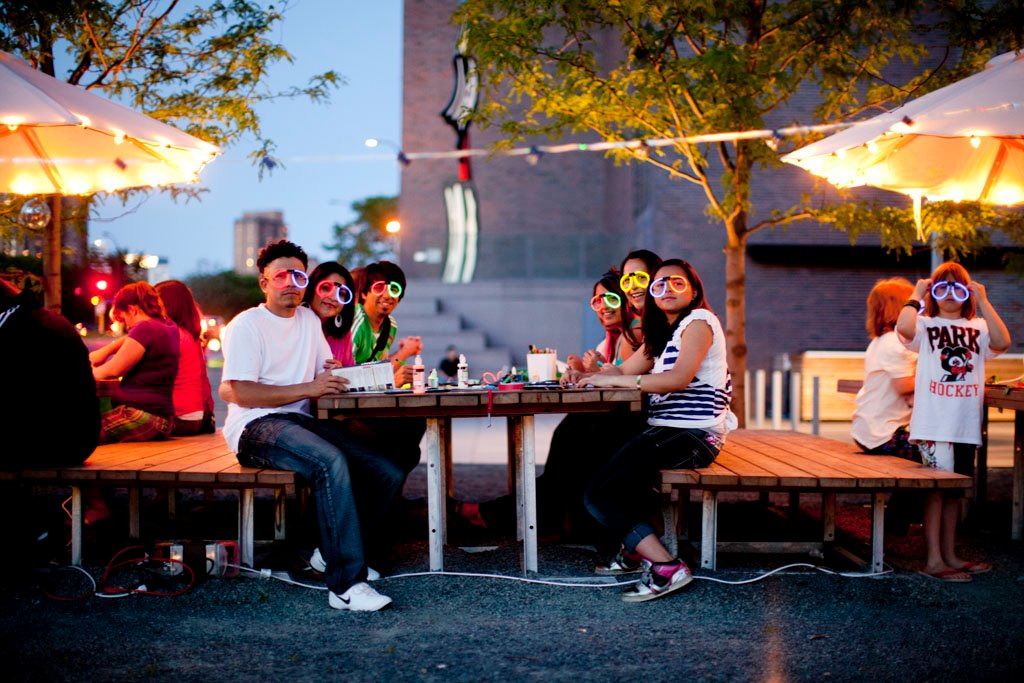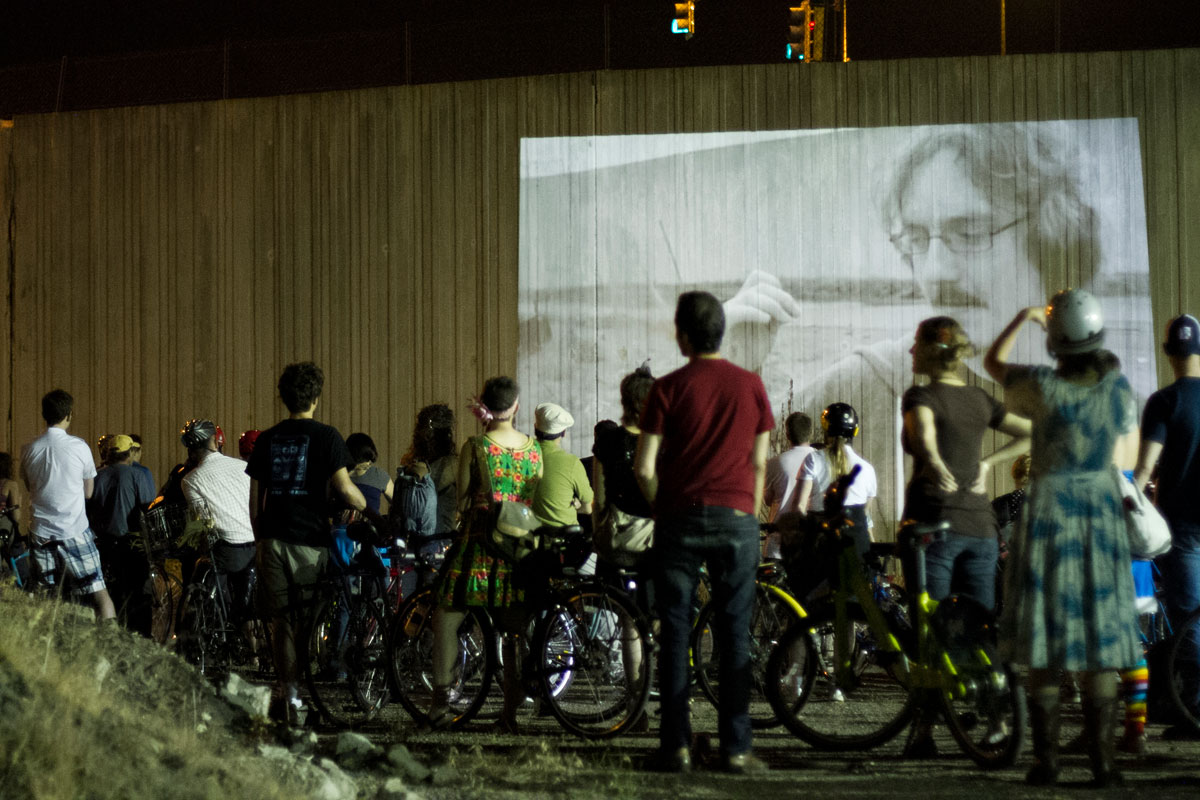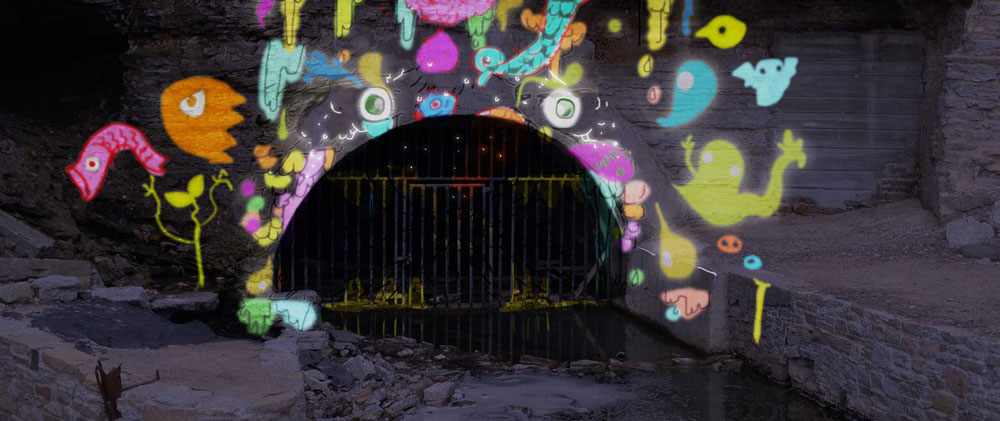Night Lights in the City
Deborah Carver looks into Northern Spark, an all-night arts festival in the tradition of a European "nuit blanche," and situates the successful event in the historical context of other local community-oriented festivals and public art programs like it.




AFTER SUNDOWN ON JUNE 4, 2011, both Minneapolis and St. Paul hosted the Northern Spark festival, a nuit blanche in the tradition of European all-night art festivals. With projects in various locations throughout the city, the festival aimed to take advantage of the allure of the night in a way that was friendly to people who identify as creative, people who are looking for magic, and their children. It was a way to bring Disney World’s Main Street Electrical Parade to the Twin Cities. There were some of the crowds, lights, and tech-inspired artistry, without the branded characters and with the opportunity to throw around a lot more glitter. It was a giant community art project, with a little bit more pizzazz. As event founder and artistic director Steve Dietz puts it, “You’re really taken out of your skin to appreciate things in a new way.” It’s Timothy Leary out-of-body, but safer, and for the constantly be-screened.
American public art follows a slightly different trend trajectory than the kind you see in museums. In American public art, monuments and memorials paved the way for the Works Progress Administration, which set the example by commissioning more playful public works in the outdoor galleries of the 70s and 80s — like the Minneapolis Sculpture Garden. A little over a decade ago, bedazzling a city with fiberglass cows or frogs or Peanuts characters was in vogue. Now we’ve transitioned into full Debordian spectacle, where such space-making involves lights, sound, and recognition of all attendees’ creativity through participation. When it’s not burdened by history and context, public art has always walked the line between ridiculous and marketable — and Northern Spark is no exception.
During the festival’s first incarnation, an estimated 50,000 visitors from the metro area visited the two cities through the night Saturday, June 4, until sunrise Sunday morning. Billed as a “participatory public art event,” visitors attended cultural sites like the Walker Art Center, Science Museum of Minnesota, St. Paul Public Library, Stone Arch Bridge, and Loring Park. As fits the screen-centric nature of contemporary culture, artwork was projected onto and from buildings throughout the cities. Projects involved bicycles with lit-up sperm-shaped helmets, parades with community bands, processions with well-designed furniture, and a variety show-style learning experience along a Mississippi River paddleboat. Participants wandered through an installation of strung lightbulbs that felt like walking through a field of fireflies, or stars. Technical difficulties prevented the realization of a much-anticipated project; Andrea Stanislav’s Nightmare‘s never completed its ephemeral gallop down the river. But no matter. Visitors could also attend an art car symphony, see a world-famous cartoonist draw for a crowd with a giant pen at the Walker’s Open Field, or they could dance their hearts out in Lowertown.
What’s remarkable is Northern Spark’s immediate success as a community-oriented arts project. After all, the Twin Cities hold abundant opportunities for residents to participate in the arts, in ways well beyond the average family’s annual journey to Spoonbridge and Cherry. Events like Art-A-Whirl, Uptown Art Fair, and the St. Paul Art Crawl take a more traditional visual artist vs. patron tack, marked by gaze-gape-and-buy behavior; neighborhood-centered projects, like Powderhorn’s Art Sled Rally and May Day parade, draw crowds from throughout the city as well, mixing politics, participation, spectacle and papier mache to demonstrate just how grand “hand-crafted” can be. Red Hot Art gives the Stevens neighborhood’s young artists a chance to display their talents for a lingering local audience; West Bank Music Festival highlights the variety of venues right around the University of Minnesota; FLOW Northside showcases the art, business, and culture of north Minneapolis; and last year’s Constellation event provided an esoteric look at artists living and working in south Minneapolis. The Art Shanty Projects abandon neighborhoods entirely, building a brand new community of artists in temporary ice houses on Medicine Lake in each of the winter festival’s eight iterations since 2004. “Placemaking” initatives, like St. Paul’s Irrigate project, fuse artists and organizations with the communities of the Central Corridor, with the ultimate goal of building community engagement through art.
Apart from the arts sector and cultural events, there are still more opportunities for civic participation. For example, on the same day as last year’s Northern Spark festival, 2,000 volunteers from the metro area headed to the Northside for the City of Minneapolis’s official day of cleanup after the May 22, 2011 tornado. This past fall in downtown Minneapolis, Peavey Plaza and the Hennepin County Government Center were transformed into arenas for civic dissent and active engagement with the presence of protesters of Occupy Minneapolis. And this month, Twin Cities Pride Parade will take on special significance as Minnesota gears up to vote on the proposed “marriage amendment” in November. All this is to say nothing of the occasional flash mob, pecha kucha, tweed bike ride, National Night Out, TenFest, Open Field, Open Streets, etc., etc.
If, with all this, you still believe we live in a solitary, disconnected culture, devoid of artistic and community engagement, or if you think art in the Twin Cities is primarily by and for some nose-in-the-air coastie types who cling to their copies of Artforum — then you must have been spending your summers and winters indoors for the past few years. Maybe you’re looking at Facebook, but never clicking “join.”
______________________________________________________
If you think art in the Twin Cities is primarily by and for some nose-in-the-air coastie types who cling to their copies of Artforum— then you must have been spending your summers and winters indoors for the past few years. Maybe you’re looking at Facebook, but never clicking “join.”
______________________________________________________
WHAT’S PARTICULARLY STUNNING ABOUT THE FIRST NORTHERN SPARK event is that, in its first year, the festival succeeded in incorporating most of the major arts organizations in both Minneapolis and St. Paul. Right out of the gate, Northern Spark combined the most effective elements of already existing arts and cultural festivals in the metro: spread over multiple sites, like an art crawl, it’s meant to bring new audiences in to view multidisciplinary art; it’s experiential and participatory, like a art sled rally or a parade; the focus isn’t on buying anything, but on paying attention. At its best, Northern Spark brings the arts community together in a way that combines the all the appeal of old favorites (Art Shanties, ho!) with the overwhelming future-positivity of a good TED talk.
In 2012 Northern Spark won’t be as widespread over the cities. The festival will take place in a concentrated number of sites in Minneapolis, without the participation of St. Paul. Local arts juggernauts like Springboard for the Arts are not participating this year; but in their place are larger sponsors, like ad agency Carmichael Lynch and frequent Occupy-target U.S. Bank. This year, Northern Spark has relied heavily on Kickstarter campaigns; the primary crowd-sourced fundraiser for the whole project succeeded in reaching its fundraising goal that way, although just barely. Certain individual projects also held their own Kickstarter fundraisers – they were, in fact, contractually obligated by Northern Spark to do so. Only some of those were successful, but participation and further financial support from Northern Spark was not contingent upon crowd-funded success.
This year, momentum for the night-long festival seems to be flagging, particularly for some of the larger arts organizations. It’s not that surprising, considering the huge number of opportunities to occupy the streets and build community through art all year long. If you miss this opportunity to participate, you can rest assured another like it will turn up soon. In addition, many artists who created projects for last year’s Northern Spark have simply moved on to other things, either working with another community arts project, or just taking a break from the crowds.
Northern Spark is something like an apps store, a melding of screens and lights and mild amusements, designed to entertain and engage. While last year’s event covered a variety of themes – the history of the Mississippi, the miracle of life, the foreclosure crisis, youth and violence, and the kinds of dreams you get when you eat certain kinds of cheese before bed – this year, the thematic complexity of the festival’s offerings seem somewhat more subdued. Kid-friendly projects, like “make your own zine” or “yarn bomb your bike,” seem to be getting more play.
But arty nocturnal fun and light shows just don’t have the sticking power and grassroots charm of, say, the May Day Parade. The number of sites this year is greatly reduced and they’re far more condensed, with much of the activity clustered near downtown Minneapolis, particularly along the Stone Arch Bridge and Mill Ruins, with some additional spots scattered in Whittier and along the Greenway. Although organizers didn’t provide their specific criteria for choosing active sites, during our interview Dietz noted that the driving motivation behind this year’s selection was to draw as broad a public audience as possible. Finding a central public space is particularly difficult in Minneapolis, where parks and squares tend to be spread out through the city, even peripheral. The downtown and Greenway focus of this year’s iteration of the event removes Northern Spark from residential areas almost entirely – that means activities must be sought out, rather than happened upon. Even some central public spaces, including those formerly deemed public art “it” areas (notably Peavey Plaza and Peavey Park), will be left in the dark during this year’s festival.
______________________________________________________
A cheat sheet to the “zones” and events of the 2012 Northern Spark:
The 2012 festival focuses on five specific zones: on and around the Stone Arch Bridge, in a handful of galleries and skyscrapers in downtown Minneapolis, near Loring Park and at the Walker Art Center, at the Minneapolis Institute of Art and around the Midtown Greenway, and on the University of Minnesota campus and the Weisman Museum of Art. Even without the participation of St. Paul, there’s still more ground to cover than all but the most tenacious participants would be able to manage in one night. Among this year’s installations in the city, visitors will find numerous projects exploring dreams, technology and light. Each site promises projections and performances to expand participants’ cones and rods, placing nighttime spectacle in a context of other glowing exhibitions and general enjoyment of the night.
Zone A: Stone Arch Bridge
- Aniccha Arts‘ In Habit: Living Patterns will contain all-night movement underneath the Central Avenue bridge, asking the audience to consider their habits and performed behaviors – brings together late 20th century performance theory and the current rise of pop science books that ask us to consider our habits.
- Robin Schwartzman’s Think and Wonder, Wonder and Think will turn the Stone Arch Bridge into an event with giant, glowing letters broadcasting Northern Spark’s theme throughout the city.
- Along the West River Parkway, the Mobile Experiential Cinema will create narrative and atmosphere from the cityscape, and the iLounge will provide an “inhabitable social sculpture” that incorporates the iPhone’s creepiest feature, location mapping.
Zone B: Downtown Minneapolis
- The top of the Foshay Tower will turn into a personal recorder, with the Observation Tape Deck project giving participants the opportunity to record messages for other participants.
- Jim Campbell – creator of 2011’s Scattered Light installation (more commonly known as “the lightbulbs hanging over by the Science Museum”) – will take over Target Plaza with a new project called Material World.
Zone C: Walker Art Center
- At Lunalux on Harmon Place, Tamsie Ringler’s Car Dreams misses the opportunity to reference a Billy Ocean classic in a public art project, but still embodies the festival’s spirit of light and projection, with a parked car as canvas.
- The Walker Art Center will bring its Midnight Party to Open Field, with a campfire, drawing club, bedtime stories, sacrificial burnings, and interactive storytelling, topped off by Eve Sussman and Rufus Corporation’s whiteonwhite: algorithmmicnoir.
Zone D: MIA – MCAD – Midtown Greenway
- The highlight of the largest Zone of Northern Spark will be local yarn installation artist HOTTEA’s creation letting go at the Minneapolis Institute of Arts, a singular artist’s achievement providing a foil to the community participation-oriented Palace of Wonder. Also at the MIA, Peng Wu’s Midnight Mario reminds us that probably the greatest uniting factor of American culture since 1985 is the collective desire to smash bricks and collect coins while inhabiting the persona of an Italian plumber in red overalls.
- For children as well as those nostalgic for the first time they got drunk on malt liquor on the grounds of their neighborhood school, Swing All, Swing Hall keeps it going for the kidults, with the installation of a set of swings on the MCAD campus.
- Up and down the Midtown Greenway, light and bicycle-inspired projects such as Bicycle Projections, Sparkler Conversations, and Treadprint Posters keep Northern Spark self-explanatory and open to pedaling. In the Heart of the Beast’s 10 o’clock performance under the 15th Avenue Bridge is not to be missed for anyone who wonders how uncanny, strange, and marvelous the May Day Parade would be if it were held at night.
Zone E: The University of Minnesota
- The Bell Museum and the Raptor Center will inhabit the Weisman as a reminder that the University is as much about ecology as it is about technology, with programs involving bats and birds and nighttime creatures. Projections of nighttime creations will inhabit the Washington Avenue Bridge, while the Weisman Art Center will be open all night long.
- Diane Willow’s tuning the sky invites participants to immerse themselves in light and color, and Tetsuya Yamada and Clive Murphy’s Pizza/Calliope will, as expected, provide music and pizza – both projects that it seems might especially appeal to participants who have pre-enhanced their Northern Spark experience with outside substances.
______________________________________________________
Related information and links:
Northern Spark – nuit blanche Twin Cities will take place at various locations around Minneapolis from dusk, Saturday, June 9 until dawn, Sunday, June 10. Find detailed schedules, artists, performances & installations and all the participating venues here, on the festival website: http://2012.northernspark.org/index.php
Read more about mnartists.org’s participation in this year’s Northern Spark on our blog and on the Walker Art Center’s Open Field website.
Watch a short film about last year’s iteration of Northern Spark:
Northern Spark 2011 from Northern Spark on Vimeo.
______________________________________________________
About the author: Deborah Carver is a writer and editor living in Northeast Minneapolis.